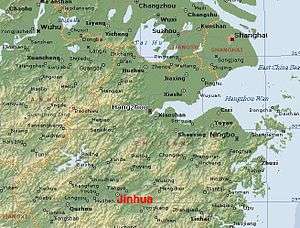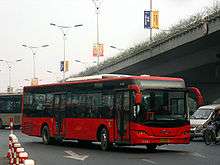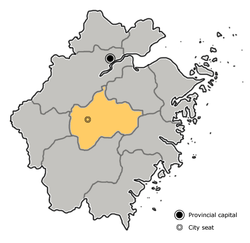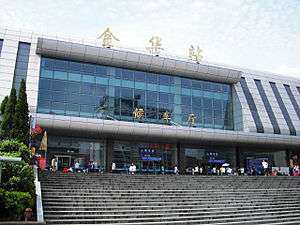Jinhua
![]() Jinhua , is a prefecture-level city in central Zhejiang province in eastern China. It borders the provincial capital of Hangzhou to the northwest, Quzhou to the southwest, Lishui to the south, Taizhou to the east, and Shaoxing to the northeast. Its population was 5,361,572 at the 2010 census including 1,077,245 in the built-up area made of two urban districts (not including the satellite city of Lanxi, which has become essentially a suburban offshoot of Jinhua's main urban area).
Jinhua , is a prefecture-level city in central Zhejiang province in eastern China. It borders the provincial capital of Hangzhou to the northwest, Quzhou to the southwest, Lishui to the south, Taizhou to the east, and Shaoxing to the northeast. Its population was 5,361,572 at the 2010 census including 1,077,245 in the built-up area made of two urban districts (not including the satellite city of Lanxi, which has become essentially a suburban offshoot of Jinhua's main urban area).
The cities of Dongyang and Yiwu are under the jurisdiction of the prefecture-level city of Jinhua in the strict administrative sense, but are often regarded as separate entities; these two cities make up the contiguous Yiwu-Dongyang metropolitan region, with a built-up area of 2,038,413 inhabitants, which is bigger than that of the urban center of Jinhua itself.
Jinhua is rich in red soil and forest resources. The Jinhua or Wu River flows through the Lan and Fuchun to the Qiantang River beside Hangzhou, which flows into Hangzhou Bay and the East China Sea. In mediaeval China, it formed part of the water network feeding supplies to the southern end of the Grand Canal. It is best known for its dry-cured Jinhua ham.
History and culture
The history of Jinhua dates back to the 2nd century BC, when it was a county subordinate to Shaoxing. It was given the name Jinhua under the Sui dynasty in AD 598 and later became the seat of a prefecture. The present city and its walls date to the time of the Mongol emperors in 1352.
The most famous native of Jinhua is Huang Chuping, a Daoist holy man of the 4th century and reputed immortal whose descendants still live in the area. Wuyang Shan ("Reclining Sheep Mountain") is said to be a sheep which was turned to stone by Huang, a trick which he learned through his years of diligently studying Daoism.
Economically Jinhua has always prospered from its position as the regional collecting and processing center for agricultural and forestry products (chiefly rice and bamboo). It is currently the second most important grain producing area in Zhejiang. In 1985 Jinhua was promoted to City status, and now is responsible for administering four cities, four counties and a district. Animals raised there include dairy cattle, meat hogs (for the production of Jinhua ham, a famous local product for 900 years) and honeybees. Jinhua's industrial sector has developed more recently, producing machinery, metallurgy, pharmaceuticals, building supplies and electrical and electronic equipment.
The Tang dynasty painter Guan Xiu[2] (Kuan-hsiu) was born in Jinhua. He is known for his paintings of Buddhist holy men.
There are numerous scenic and historical sites in the Jinhua region, including many places associated with the Immortal Huang, and a palace of the Dukes of the Taiping Heavenly Kingdom.
Geography

Jinhua is located at latitudes 28° 32'−29° 41' N and longitudes 119° 14'−120° 46' E in the center of Zhejiang. It borders Hangzhou to the northwest, Quzhou to the southwest, Lishui to the south, Taizhou to the east, and Shaoxing to the northeast.
Climate
Jinhua has a humid subtropical climate (Köppen Cfa) with four distinctive seasons, characterised by hot, humid summers and chilly, cloudy and drier winters (with occasional snow). The mean annual temperature is 17.33 °C (63.2 °F), with monthly daily averages ranging from 5.2 °C (41.4 °F) in January to 29.0 °C (84.2 °F) in July. The city receives an average annual rainfall of 1,450 millimetres (57.1 in) and is affected by the plum rains of the Asian monsoon in June, when average relative humidity also peaks.
| Climate data for Jinhua (1971−2000) | |||||||||||||
|---|---|---|---|---|---|---|---|---|---|---|---|---|---|
| Month | Jan | Feb | Mar | Apr | May | Jun | Jul | Aug | Sep | Oct | Nov | Dec | Year |
| Record high °C (°F) | 24.3 (75.7) |
27.4 (81.3) |
32.6 (90.7) |
32.9 (91.2) |
36.4 (97.5) |
37.5 (99.5) |
40.5 (104.9) |
39.3 (102.7) |
39.6 (103.3) |
35.3 (95.5) |
31.3 (88.3) |
23.8 (74.8) |
40.5 (104.9) |
| Average high °C (°F) | 9.1 (48.4) |
10.9 (51.6) |
14.8 (58.6) |
21.7 (71.1) |
26.5 (79.7) |
29.2 (84.6) |
33.8 (92.8) |
33.5 (92.3) |
28.5 (83.3) |
23.6 (74.5) |
17.9 (64.2) |
12.3 (54.1) |
21.8 (71.3) |
| Daily mean °C (°F) | 5.2 (41.4) |
6.8 (44.2) |
10.7 (51.3) |
17.1 (62.8) |
21.8 (71.2) |
25.1 (77.2) |
29.0 (84.2) |
28.6 (83.5) |
24.1 (75.4) |
18.9 (66) |
13.2 (55.8) |
7.4 (45.3) |
17.3 (63.1) |
| Average low °C (°F) | 2.2 (36) |
3.7 (38.7) |
7.3 (45.1) |
13.3 (55.9) |
18.2 (64.8) |
21.9 (71.4) |
25.3 (77.5) |
24.9 (76.8) |
20.8 (69.4) |
15.3 (59.5) |
9.4 (48.9) |
3.8 (38.8) |
13.8 (56.9) |
| Record low °C (°F) | −9.6 (14.7) |
−8.9 (16) |
−1.6 (29.1) |
0.6 (33.1) |
8.7 (47.7) |
13.3 (55.9) |
18.8 (65.8) |
18.6 (65.5) |
13.1 (55.6) |
2.4 (36.3) |
−2.7 (27.1) |
−6.8 (19.8) |
−9.6 (14.7) |
| Average precipitation mm (inches) | 71.5 (2.815) |
91.6 (3.606) |
160.1 (6.303) |
168.9 (6.65) |
186.6 (7.346) |
258.5 (10.177) |
129.5 (5.098) |
109.1 (4.295) |
103.1 (4.059) |
68.9 (2.713) |
55.9 (2.201) |
47.9 (1.886) |
1,451.6 (57.149) |
| Average precipitation days (≥ 0.1 mm) | 13.4 | 14.5 | 18.5 | 17.1 | 16.1 | 16.5 | 12.4 | 11.9 | 11.2 | 9.6 | 8.2 | 8.6 | 158.0 |
| Source: Weather China | |||||||||||||
Administrative divisions
The prefecture-level city of Jinhua administers 9 county-level divisions, including 2 districts, 4 county-level cities and 3 counties.
| Map | ||
|---|---|---|
| Subdivision | Simplified Chinese | Pinyin |
| Wucheng District | 婺城区 | Wùchéng Qū |
| Jindong District | 金东区 | Jīndōng Qū |
| Lanxi | 兰溪市 | Lánxī Shì |
| Yongkang | 永康市 | Yǒngkāng Shì |
| Yiwu | 义乌市 | Yìwū Shì |
| Dongyang | 东阳市 | Dōngyáng Shì |
| Wuyi County | 武义县 | Wǔyì Xiàn |
| Pujiang County | 浦江县 | Pǔjiāng Xiàn |
| Pan'an County | 磐安县 | Pán'ān Xiàn |
These are further divided into 191 township-level divisions, including 107 towns, 73 townships and 11 subdistricts.
Economy
Jinhua has a rather flexible economic system with distinctive economic characteristics in different areas. 90% of enterprises are in and about 88% of its GDP are from private sector.
Industry

Jinhua enjoys an advanced civilian-owned economy, with its industry mainly supported by processing and manufacturing. Leading industries of the city include clothing and textile, mechanics and electronics, pharmacy and chemistry, manufacturing crafts, metalwork processing architecture and building materials, automobile-and-motorcycle accessories, food processing, and plastic ware.
Industries are distributed with different characteristics in different counties or county-level cities. For instance, Yiwu is characterized by its light-industry commodities, Yongkang by its automobile-and-motorcycle accessories and mechanical and electric tools, Dongyang by its clothing, architecture and magnetic materials, the Jinhua Proper by its pharmacy, construction materials and industrial measures, Lanxi by its non-ferrous metal, cement, towels and daily chemicals, and Pujiang by its textile, lockmaking, and lantern ornaments of crystals.
Handicrafts
Traditional handicrafts have been flourishing in Jinhua. The wood carving and bamboo weaving in Dongyang, the straw plaiting, lace purling and crystals carving in Pujiang, and the hardware crafts in Yongkang, all enjoy a long history of development and the products sell well both abroad and at home.
Transportation
Jinhua is approximately three hours by car from Shanghai. There is also the D-train which takes approximately 2.5 hours, or about four hours by ordinary train.
Jinhua enjoys convenient transportation, being the communications center in Southeast China between coastal and inland areas, and one of the major hubs of landway transportation in the country. The Zhejiang-Jiangxi, Jinhua-Wenzhou and Jinhua-Qiandaohu Railways intersect in the City. The Hangzhou-Jinhua-Quzhou Expressway, the Jinhua-Lishui-Wenzhou Expressway, the No. 330 and 320 National Highways, and other provincial highroads, also traverse the area. The city aggregation around Jinhua Proper has formed a "Half-an-Hour's-Ride Economic Circle", there being merely a 90-minute and a 3-hour journey driving from the city to Hangzhou and Shanghai respectively. At present, Yiwu Airport offers airlines destined for Beijing, Shanghai, Guangzhou, Shenzhen, Xiamen, Qingdao, and Hong Kong.
Landmarks
Jinhua Architecture Park, a collection of 17 pavilions designed by Chinese and international architects, set on the banks of the Yiwu River.
China's Wuju opera theatre,mainly for opera, ballet, drama, concerts, variety show comprehensive cultural facilities, is one of the landmark building of jinhua city. It is located in Jinhua city east city south street, west of bing rainbow Jin Huajiang north of east road, yiwu, jiang Wu Yijiang sanjiang interchange Dovetail State Park area
References
External links
- Government website of Jinhua (Chinese)
- Government website of Jinhua(English)
- Jinhua First Social Welfare Institute (orphanage)
- The Jinhua Swine, breeds of livestock


.svg.png)

